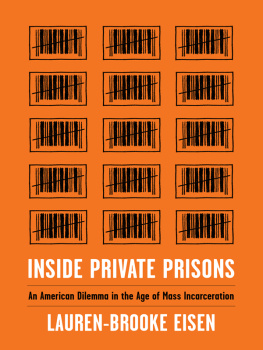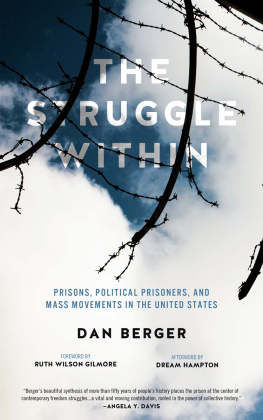MASS INCARCERATION
ON TRIAL
Also by Jonathan Simon
Governing Through Crime


Copyright 2014 by Jonathan Simon
All rights reserved.
No part of this book may be reproduced, in any form, without written permission from the publisher.
Requests for permission to reproduce selections from this book should be mailed to: Permissions Department, The New Press, 120 Wall Street, 31st floor, New York, NY 10005.
Published in the United States by The New Press, New York, 2014 Distributed by Perseus Distribution
LIBRARY OF CONGRESS CATALOGING-IN-PUBLICATION DATA
Simon, Jonathan, 1959 author.
Mass incarceration on trial : a remarkable court decision and the future of prisons in America / Jonathan Simon.
pages cm
Includes bibliographical references and index.
ISBN 978-1-59558-792-3 (e-book) 1. PrisonsLaw and legislationUnited States. 2. Correctional lawUnited States. 3. Administration of criminal justiceUnited States. 4. PunishmentLaw and legislationUnited States. I. Title.
KF9730.S56 2014
344.7303'5dc23
2013045415
The New Press publishes books that promote and enrich public discussion and understanding of the issues vital to our democracy and to a more equitable world. These books are made possible by the enthusiasm of our readers; the support of a committed group of donors, large and small; the collaboration of our many partners in the independent media and the not-for-profit sector; booksellers, who often hand-sell New Press books; librarians; and above all by our authors.
www.thenewpress.com
Composition by Westchester Book Composition
This book was set in Palatino
10 9 8 7 6 5 4 3 2 1
This book is dedicated to my mother, Marlene Bragman Simon, whose passion for confronting social problems and seeking social justice has always served as a beacon for my research
Contents
The author is grateful for the comments on some or all of the manuscript from Jed Bickman, Andrew Coyle, Ian Cummings, Malcolm Feeley, Ruth Gilmore, Richard Jones, Shadd Maruna, Kieran McEvoy, Tony Platt, Marlene Simon, Richard Sparks, Diane Wachtell, and Frank Zimring. As always, all failures of fact and interpretation belong solely to the author.
MASS INCARCERATION
ON TRIAL
Like a biblical flood, the age of mass incarceration is finally ebbing. After forty yearsnot forty daysa once unstoppable tide of harsh sentencing laws, aggressive prosecution policies, and diminished opportunities for parole seems to be subsiding. Today the number of people imprisoned in America remains at or near historic highs (nearly four times the average incarceration rate for the first three quarters of the twentieth century), but the quantitative trend is modestly downward. States have begun to modify some of the most extreme sentencing laws, including New Yorks infamous Rockefeller Drug Laws, which created life sentences for first-time possession of modest quantities of drugs for sale, and once impossible discussions of alternatives to routine imprisonment for many drug and property crimes are beginning to take place at the state level.
But although the levels have stopped rising, the flood of mass incarceration is still upon us, and the effects of what has been done remain, largely below the surface. Beyond the numbers, the quantitative story of mass incarceration,
Despite being a specialist in the study of punishment and society, even an early identifier of some of the critical features that have come to define mass incarceration, I did not know enough to ask these questions, let alone begin to think about answering them, until the end of the last decade, some thirty-five years into the age of mass incarceration and a quarter century after I had begun to study it. The source of this late insight was an unusual federal trial held before a special three-judge court in 2009. That case, Coleman-Plata v. Schwarzenegger, was a consolidation of two independent but related ongoing federal court cases covering California prisons: Coleman v. Wilson, a 1995 case ordering comprehensive improvements to mental health care delivery in prisons, and Plata v. Davis, a 2002 negotiated agreement in which California admitted systemwide violations of its constitutional requirement to provide adequate medical care in its prison system. This litigation revealed a depth of depravity in Californias prisons that most academic critics, including me, had not imagined. When the Supreme Court reviewed the California decision, the result was a resounding legal victory for prisoners. The majority opinion in Brown v. Plata drew a direct line between the sentencing practices of mass incarceration and the inhumane conditions in prisonsthe quantitative and qualitative stories. The majority, while only one vote strong, powerfully proclaimed the human dignity of prisoners and the requirement to provide humane conditions as core animating values of constitutional punishment.
This book attempts to use the California court decisions leading up to and including Brown v. Plata to show the way toward a legal dismantling of mass incarceration. If, as those cases cumulatively seem to imply, imprisonment on the scale that currently exists in California is fundamentally incompatible with humane conditions, if the physical and mental health requirements of prisoners cannot be constitutionally met on a mass scale, then mass incarceration is inherently unconstitutional. It is therefore incumbent on usand constitutionally requiredto examine and change our use of incarceration as the primary response to crime.
* * *
The term mass incarceration was first used by specialists in the field of punishment and society to describe the tremendous changes in the scale of incarceration that began in the late 1970s and became visible to readers of imprisonment charts by the middle of the 1980s. Twenty-five years later, these critiques have begun to gain some traction politically, boosted by the recent economic crisis that has forced state political leaders to consider cuts even to the once sacrosanct correctional budget, as well as by the happier fact that most of the very significant crime reductions throughout the United States during the 1990s have so far been sustained despite the hard economic times.
It remains to be seen, however, if these trends by themselves can drive a sustained reduction in incarceration rates. Many of the laws and policies that produced mass incarceration remain firmly in place. More important, so do the habituated responses
For all the powerful and damning labels that have been laid on itthe prison industrial complex, the human waste management system, and most recently and perhaps most memorably, the new Jim Crowmass incarceration retains legitimacy among people in general and the legal elites (judges, legislators, prosecutors) most likely to influence its immediate course. The claim that it keeps the innocent safe from the guilty sounds glib and inherently contradictory to those of us who are familiar with the social realities of criminal victimization, but it is neither obviously spurious nor, broadly speaking, disingenuous. In the words of a legal decision, Spain v. Procunier, that has become a talisman for the legitimacy of mass incarceration in the federal courts, prisons keep dangerous men in safe custody under humane conditions.
Mass incarceration, however, defies all three of the promises implicit in the Spain decision. Imprisonment on the scale currently practiced by the United States has meant that literally millions of people
Next page
















